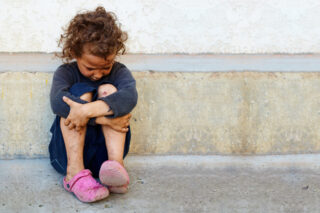
More Child Health and Safety Articles
Childhood Poverty

It is estimated that one in five U.S. children lives in poverty, and poverty is an important determinant to a child’s overall health.
Children being raised in poverty (defined as income of $24,036 or less in 2015, for a family of four with two children) are at a higher risk for a wide range of problems.
Hispanic and black children are much more likely to live in poor families than are non-Hispanic white and Asian children. In 2015, 12% of both non-Hispanic white and Asian children were poor, compared with 29% of Hispanic children, and 33% of black children. In the same year, Hispanics and blacks were also more likely than non-Hispanic whites and Asians to live in low-income families (61% each, versus 29 and 27%, respectively). Black children were more likely than Hispanic children to be in deep poverty (16 and 12%, respectively), and both were more likely to be in deep poverty than white or Asian children (6%, each).
Effects Of Child Poverty
Psychological research on the effects of child poverty on our nation’s children has demonstrated that living in poverty has a wide range of negative effects on the physical and mental health and well-being of our nation’s children. Poverty impacts children within their various contexts at home, in their school, and in their neighborhoods and communities.
Poverty has been linked with negative conditions such as substandard housing, homelessness, inadequate nutrition and food insecurity, inadequate child care, lack of access to health care, unsafe neighborhoods, and under-resourced schools which adversely impact our nation’s children.
Poorer children and teens are at a greater risk for several negative outcomes such as poor academic achievement, school dropout, abuse and neglect, behavioral and socioemotional problems, physical health problems, and developmental delays.
These effects are compounded by the barriers that children and their families encounter when trying to access physical and mental health care.
Academic Achievement and Poverty
Poverty has an adverse effect on the academic outcomes of children, especially during early childhood. Research shows that 40% of children living in poverty aren’t prepared for primary schooling.
Living in poverty with chronic stress has been shown to adversely affect children’s concentration and memory, which may impact their ability to learn. Children that live below the poverty line are 1.3 times more likely to have developmental delays or learning disabilities than those who don’t live in poverty.
Dropout rates of 16 to 24-year-old students who come from low-income families are seven times more likely to drop out than those from families with higher incomes.
Psychosocial Outcomes and Poverty
Children living in poverty are at greater risk of behavioral and emotional problems. Some behavioral problems may include impulsiveness, difficulty getting along with peers, aggression, attention-deficit/hyperactivity disorder (ADHD) and conduct disorder. Some emotional problems may include feelings of anxiety, depression and low self-esteem.
Poverty and economic hardship is difficult for parents who may experience chronic stress, depression, marital distress and exhibit harsher parenting behaviors. These are all linked to poor social and emotional outcomes for children.
Unsafe neighborhoods may expose low-income children to violence which can cause a number of psychosocial difficulties. Violence exposure can also predict future violent behavior in youth, which places them at greater risk of injury and mortality and entry into the juvenile justice system.
Physical Health and Poverty
Children and teens who live in poorer communities are at increased risk for a wide range of physical health problems, such as low birth weight and poor nutrition, which is manifested in the following ways:
- Inadequate food which can lead to food insecurity/hunger
- Lack of access to healthy foods and areas for play or sports, which can lead to childhood overweight or obesity
They are also at an increased risk for chronic conditions such as asthma, anemia and pneumonia; risky behaviors such as smoking or engaging in early sexual activity; and exposure to environmental contaminants, e.g., lead paint and toxic waste dumps.
There are no easy solutions to reducing child poverty or alleviating its consequences. Research suggests that a combination of parental effort and social programs – correctly designed and implemented – can improve the lives of poor children and their families.
Volunteer your time with charities and organizations that provide assistance to low-income and homeless children and families. Donate money, food, and clothing to homeless shelters and other charities in your community. Donate school supplies and books to under resourced schools in your area.
Let your voice be heard. Support public policy initiatives that are seeking to:
- Improve access to physical, mental, and behavioral health care for low-income Americans by eliminating barriers such as limitations in health care coverage.
- Create a “safety net” for children and families that provides real protection against the harmful effects of economic insecurity.
- Increase resources for public education and access to higher education.
- Support research on poverty and its relationship to health, education, and well-being.
Other Articles You May Find of Interest...
- Nurturing Emotional Resilience in Children: A Guide For Parents
- Springtime Allergies: Exploring Holistic Options For Relief
- Healthy Snacks For Your Children
- Twelve Valuable Parenting Principles
- Nurturing Healthy Sleep Habits in Infants and Toddlers
- Children’s Health and Spring Time
- Chiropractic Care For Your Child

















